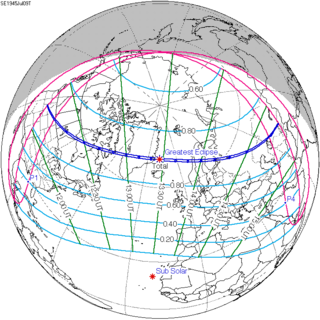| Solar eclipse of July 9, 1945 | |
|---|---|
| Type of eclipse | |
| Nature | Total |
| Gamma | 0.7356 |
| Magnitude | 1.018 |
| Maximum eclipse | |
| Duration | 75 s (1 min 15 s) |
| Coordinates | 70°00′N 17°12′W / 70°N 17.2°W |
| Max. width of band | 92 km (57 mi) |
| Times (UTC) | |
| Greatest eclipse | 13:27:46 |
| References | |
| Saros | 145 (18 of 77) |
| Catalog # (SE5000) | 9387 |
A total solar eclipse occurred at the Moon's ascending node of orbit on Monday, July 9, 1945,[1] with a magnitude of 1.018. A solar eclipse occurs when the Moon passes between Earth and the Sun, thereby totally or partly obscuring the image of the Sun for a viewer on Earth. A total solar eclipse occurs when the Moon's apparent diameter is larger than the Sun's, blocking all direct sunlight, turning day into darkness. Totality occurs in a narrow path across Earth's surface, with the partial solar eclipse visible over a surrounding region thousands of kilometres wide. Occurring about 4.4 days after perigee (on July 5, 1945, at 4:40 UTC), the Moon's apparent diameter was larger.[2]
The path of totality crossed Oregon, Idaho, and Montana in the northwestern United States, much of central and northeastern Canada, across Greenland and into Scandinavia, the western Soviet Union, and central Asia. A partial eclipse was visible for parts of North America, Europe, North Africa, West Asia, and the Soviet Union. The eclipse was mostly seen on July 9, 1945, except for northeastern Soviet Union, where a partial eclipse was seen on July 10 local time, or starting on July 9, passing midnight and ending on July 10 due to the midnight sun.
- ^ "July 9, 1945 Total Solar Eclipse". timeanddate. Retrieved 4 August 2024.
- ^ "Moon Distances for London, United Kingdom, England". timeanddate. Retrieved 4 August 2024.
